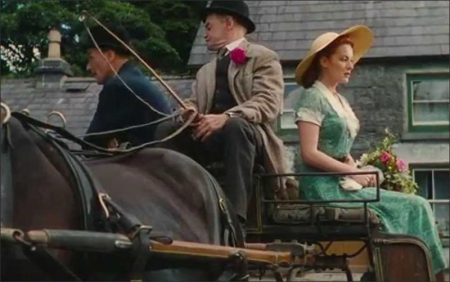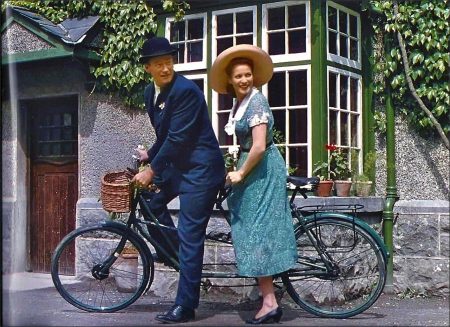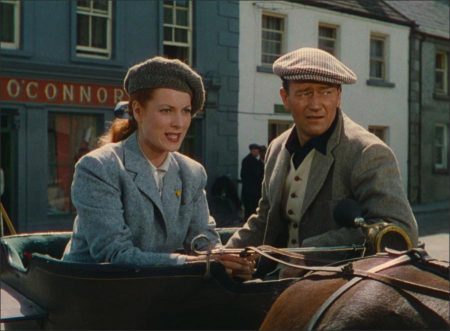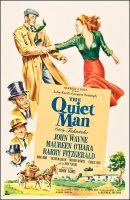The Quiet Man movie storyline. Returning to the Ireland of his birth, director John Ford fashions a irresistable valentine to the “Auld Sod” in The Quiet Man. Irish-American boxer John Wayne, recovering from the trauma of having accidentally killed a man in the ring, arrives in the Irish village where he was born. Hoping to bury his past and settle down to a life of tranquility, Wayne has purchased the home of his birth from wealthy local widow Mildred Natwick, a transaction that has incurred the wrath of pugnacious squire Victor McLaglen, who coveted the property for himself.
By and by, Wayne falls in love with McLaglen’s beautiful, high-spirited sister Maureen O’Hara. Her insistence that Wayne conduct his courtship in a proper Irish manner-with puckish matchmaker Barry Fitzgerald along for the ride as “chaperone”–is but one obstacle to their future happiness: the other is McLaglen, who spitefully refuses to give his consent to his sister’s marriage, or to honor the tradition of paying a dowry to Wayne. Wayne could care less about dowries, but the tradition-bound Maureen refuses to consummate her marriage until McLaglen pays up.
Under any other circumstances, Wayne would have punched out the bullying McLaglen long ago, but ever since his tragedy in the ring he has been reluctant to fight. Local priest Ward Bond conspires with several locals to trick McLaglen into paying his due. They intimate that widow Natwick, for whom McLaglen carries a torch, will marry the old brute if he’ll give his consent to the marriage and fork over the dowry. But McLaglen finds he’s been tricked and the situation remains at a standoff, with the frustrated Wayne locked out of his wife’s bedroom.
When Maureen accuses him of being a coward and walks out on him, our hero can stand no more. He marches Maureen to McLaglen’s home, indicating that he plans to whale the tar out of both brother and sister. As a huge and appreciative crowd gathers the cornered McLaglen truculently tosses the money in Wayne’s direction. Big John hands the bills to Maureen, just as she knew he would, and she ceremoniously destroys the money, just as he knew je would. Having proven their love for each other, there is nothing left for Wayne and Maureen to do but head home and perform their nuptual duties.
But first there’s the matter of giving McLaglen the thrashing he deserves….and it is this spectacular donnybrook, which covers several acres of land and at least two “pit stops” so that the combatants can quench their thirst, which convinces Natwick that the defeated McLaglen is truly worthy of her love (her logic is on a par with everyone else’s in the film!) Though it tends to perpetuate the myth that all true Irishmen live only to fight, drink and make love,
The Quiet Man is grand and glorious fun, enacted with gusto by a largely Hibernian cast and directed with loving care by a master of his craft. Written by Frank Nugent and graced with a lilting musical score by Victor Young, the film won Oscars for Archie Stout’s Technicolor photography and for John Ford’s direction-a real coup for “poverty row” Republic Pictures. If you haven’t already luxuriated in this wonderful film, be sure to catch in on the tube next St. Patrick’s Day.
About the Film
The Quiet Man (1952) is director John Ford’s epic romantic comedy – a loving, sentimental, nostalgic tribute to his Irish ancestry and homeland. A rich, beautifully-textured Technicolor presentation deserving of its Color Cinematography award, it was filmed mostly on location in Ireland, although some backdrops and background studio shots were obviously intermixed. Its screenplay was based on Frank Nugent’s adaptation of Maurice Walsh’s Saturday Evening Post 1933 short story Green Rushes. Ford considered the rollicking, comedy love story one of his favorite films.
The memorable plot, about the collision course between an anti-materialistic, Irish-American boxer nicknamed ‘Trooper Thornton’ (Wayne) in the town of Innisfree in the land of his Irish birthplace and a local, mean bully (McLaglen) – further entangled when he falls in love with the man’s fiesty, red-haired, materialistic sister (O’Hara) who refuses to consummate her marriage without her dowry (350 Irish pounds in gold), was inspired by a Celtic myth about a monumental battle between two sacred kings (gods) who annually fought for the affections of a queen (or goddess).]
The famous director of westerns had already won Best Director Academy Award Oscars for three previous non-Western films – The Informer (1935), The Grapes of Wrath (1940), and How Green Was My Valley (1941). This sentimental film, Ford’s first ‘romantic love story,’ received a total of seven Academy Awards nominations (including Best Picture, Best Supporting Actor – Victor McLaglen, Best Screenplay – Frank Nugent, Best Art Direction, and Best Sound) and won two Oscars: Best Cinematography – Winton Hoch and Archie Stout, and Ford (at 57 years of age) won his fourth and final Best Director Oscar, establishing a record that is still unbeaten.
The Quiet Man is a 1952 Technicolor American romantic comedy-drama film directed by John Ford. It stars John Wayne, Maureen O’Hara, Barry Fitzgerald, Ward Bond and Victor McLaglen. The screenplay by Frank S. Nugent was based on a 1933 Saturday Evening Post short story of the same name by Maurice Walsh, later published as part of a collection The Green Rushes. The film is notable for Winton Hoch’s lush photography of the Irish countryside and a long, climactic, semi-comic fist fight. It was an official selection of the 1952 Venice Film Festival.
The Quiet Man won the Academy Award for Best Director for John Ford, his fourth, and for Best Cinematography. In 2013, the film was selected for preservation in the United States National Film Registry by the Library of Congress as being “culturally, historically, or aesthetically significant”.
The Quiet Man (1952)
Directed by: John Ford
Starring: John Wayne, Maureen O’Hara, Barry Fitzgerald, Ward Bond, Victor McLaglen, Mildred Natwick, Francis Ford, Eileen Crowe, May Craig, Arthur Shields, Charles B. Fitzsimons, James O’Hara
Screenplay by: Frank S. Nugent
Cinematography by: Winton C. Hoch
Film Editing by: Jack Murray
Costume Design by: Adele Palmer
Set Decoration by: John McCarthy Jr., Charles S. Thompson
Art Direction by: Frank Hotaling
Music by: Victor Young
Distributed by: Republic Pictures
Release Date: August 14, 1952
Visits: 295



